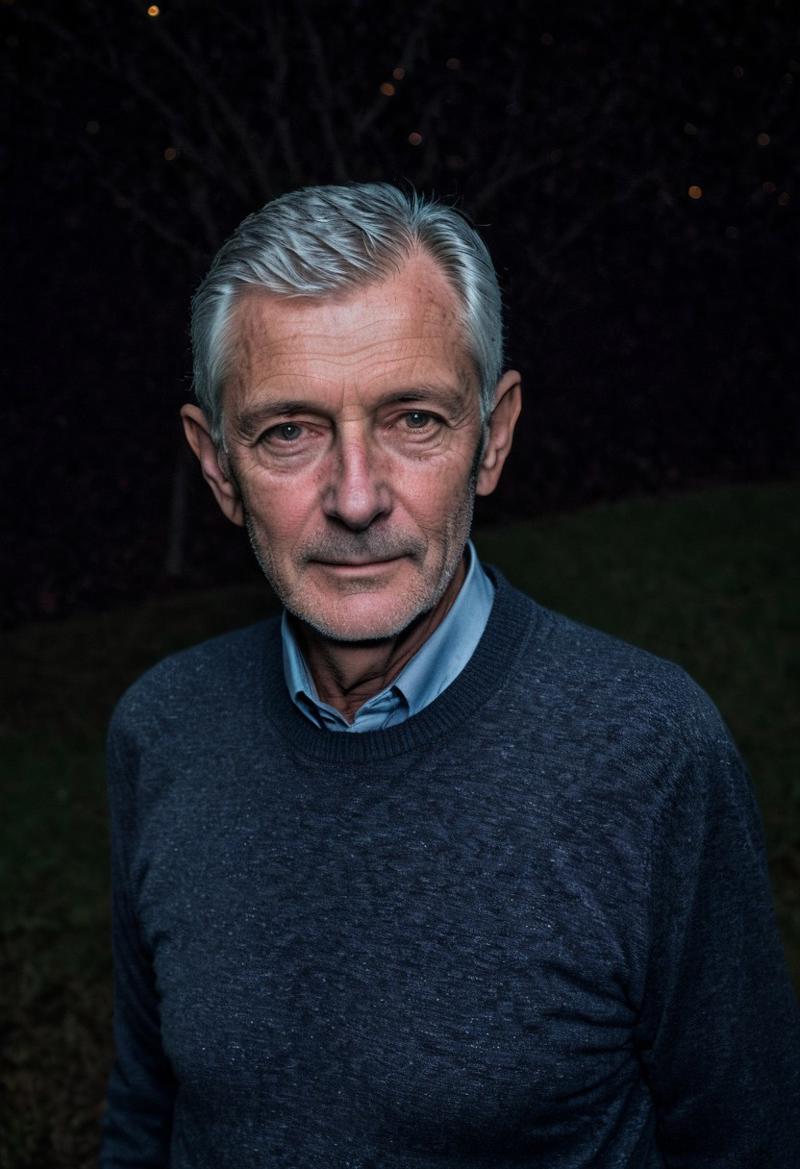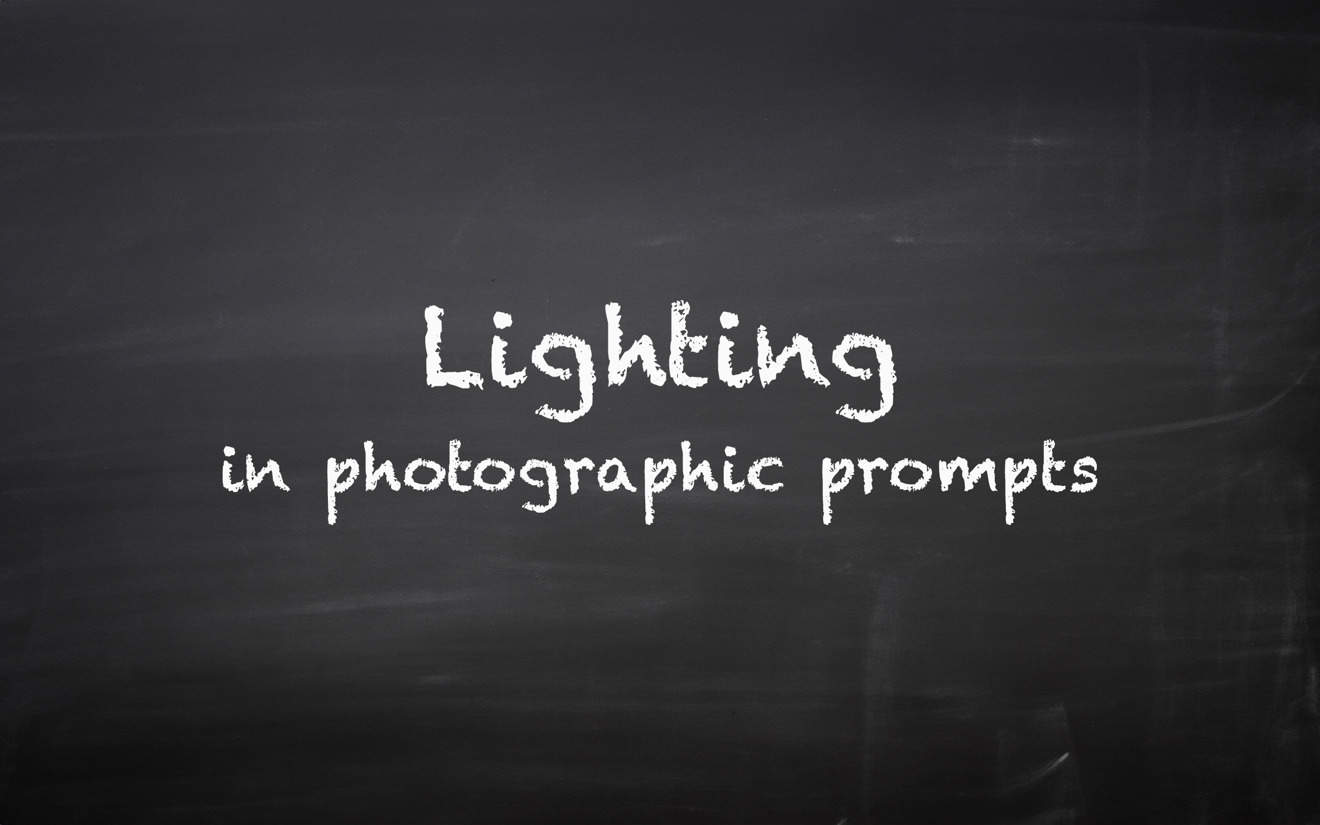This article will cover some usefull lighting keywords, that can be used in photo related prompts.
Basics
Lets start with our base prompt and no further adjustments.
To follow the guide you can use the following generation data. The results may vary on the subject and the checkpoint/ model you are using.
Positive Prompt: Portrait of a 65yo man, short grey hair, background is a city scene, bokeh, highly detailed, Fujifilm XT-4Negative Prompt: Ugly, blurry, bad quality, low qualitySteps: 25, Sampler: dpmpp_2m_karras, CFG Scale: 6.5, Seed: 590596501731861, Size: 832x1216, Model hash: 364cecf630, Model: realvisxlV30_v30Bakedvae, Version: ComfyUI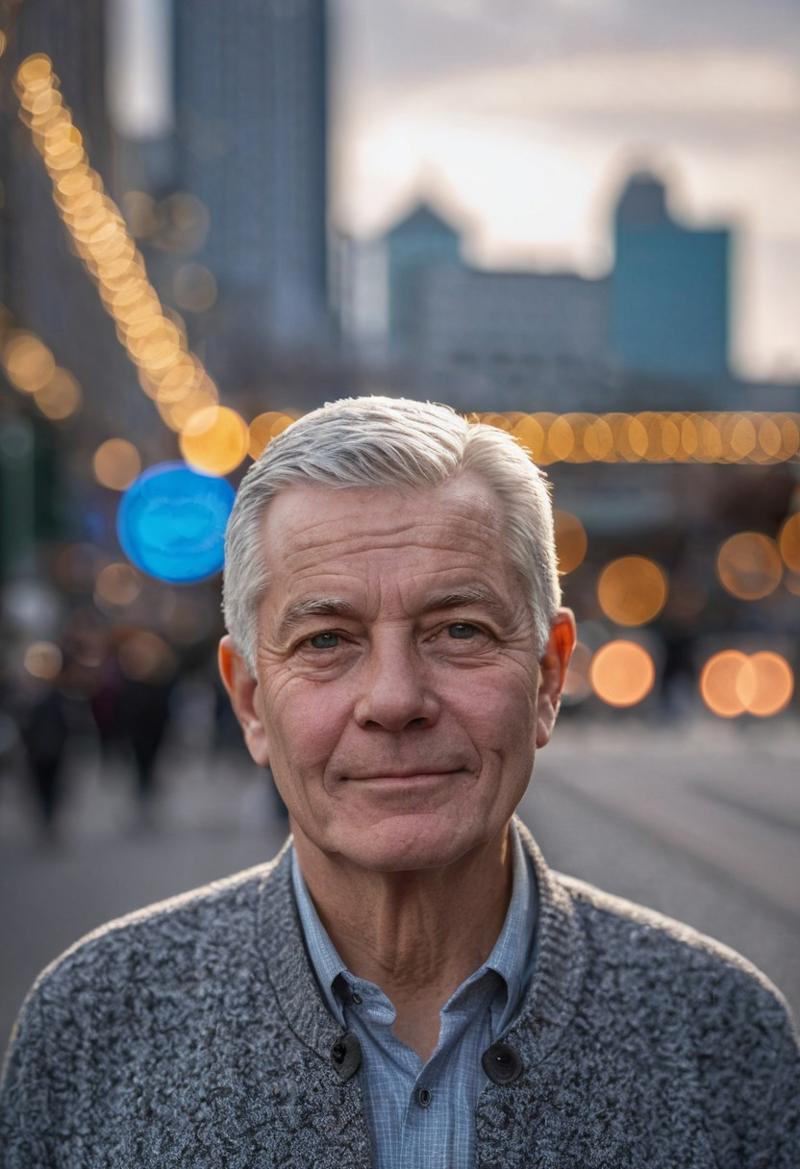
Lighting scenarios
The structure of the prompt is really straight-forward. Just add the desired lighting in front of the prompt.
[LIGHTING SCENARIO], other parts of the promptBlue Hour Photography
Blue hour photography refers to capturing images during the period of time shortly before sunrise or after sunset when the sky takes on a deep blue hue. This time frame occurs when the sun is just below the horizon, and the indirect sunlight scattered in the atmosphere creates a beautiful blue-toned light.
Photographers often seek out the blue hour for its unique and tranquil atmosphere, characterized by soft, diffused lighting. The blue tones can add a serene and ethereal quality to landscapes, cityscapes, and various scenes. It's a particularly popular time for capturing city lights against the backdrop of the deep blue sky. Blue hour photography requires attention to timing, as the duration of the blue hour is relatively short, providing a narrow window of opportunity for capturing these captivating moments.
Blue Hour Photography , Portrait of a 65yo man, short grey hair, background is a city scene, bokeh, highly detailed, Fujifilm XT-4
Daylight Photography
Daylight photography involves capturing images during the natural daylight hours, using the ambient light provided by the sun. Photographers utilize varying qualities of light depending on the time of day, weather conditions, and geographic location.
Daylight photography can offer diverse looks, ranging from the soft and warm tones during sunrise and sunset (golden hour) to the more direct and cooler light during midday. The availability of natural light allows photographers to showcase colors, textures, and details authentically. Daylight photography is versatile and can be employed in various settings, from outdoor landscapes to portraits, providing different moods and atmospheres based on the specific characteristics of the daylight at the time of shooting.
Daylight Photography, Portrait of a 65yo man, short grey hair, background is a city scene, bokeh, highly detailed, Fujifilm XT-4
Golden Hour Photography
Golden hour photography refers to capturing images during the periods shortly after sunrise and before sunset when the sun is near the horizon, casting a warm and soft golden glow across the landscape. This magical time is characterized by diffused and flattering light that enhances colors, textures, and adds a warm ambiance to the scene.
Photographers often seek out the golden hour for its ideal lighting conditions, which reduce harsh shadows and create a more even and appealing illumination. The unique qualities of the golden hour light make it particularly suitable for a variety of photography genres, including portraits, landscapes, and architectural photography. Timing is crucial, as the duration of the golden hour is relatively short, providing a narrow window to capture the enchanting effects of this magical light.
Golden Hour Photography , Portrait of a 65yo man, short grey hair, background is a city scene, bokeh, highly detailed, Fujifilm XT-4
Low-Light Photography
Low-light photography involves capturing images in conditions where the available light is limited, such as during dusk, dawn, or in indoor settings with dim lighting. This style of photography often requires specialized techniques, equipment, or adjustments to camera settings to compensate for the reduced light levels.
Photographers may use larger apertures, slower shutter speeds, higher ISO settings, and sometimes external light sources like flashes or artificial lights to achieve proper exposure in low-light conditions. Low-light photography can create dramatic and moody effects, capturing scenes with unique atmospheres and emphasizing the play of light and shadow. It is commonly employed in various situations, including night photography, indoor events, or capturing the ambiance of twilight.
Low-Light Photography , Portrait of a 65yo man, short grey hair, background is a city scene, bokeh, highly detailed, Fujifilm XT-4
Natural Light Photography
Natural light photography is a style of photography that relies solely on ambient or available light, as opposed to artificial lighting sources. Photographers using natural light leverage the sunlight, whether direct or diffused, as well as the light from the sky during different times of the day, to illuminate their subjects.
This approach often results in a softer and more organic look, capturing the natural colors and textures of the scene. Natural light photography is commonly appreciated for its ability to convey a genuine and authentic atmosphere, particularly in outdoor settings. Photographers might choose specific times of day, such as the golden hour during sunrise or sunset, to take advantage of the warm and directional qualities of natural light.
Natural Light Photography, Portrait of a 65yo man, short grey hair, background is a city scene, bokeh, highly detailed, Fujifilm XT-4
Neon Light Photography
Neon light photography involves capturing images illuminated by neon signs or other sources of neon lighting. Neon lights create vibrant and colorful displays, adding a distinctive and electric quality to the photographs. This style of photography is often associated with urban environments, nightlife, and pop culture.
Photographers may leverage the contrast and intensity of neon lights to create visually striking compositions. The bright, saturated colors emitted by neon signs can be used to emphasize certain elements in a scene or to convey a specific mood. Neon light photography is popular for capturing the energy and atmosphere of city streets, storefronts, and entertainment districts, providing a dynamic and visually stimulating aesthetic.
(Neon Light Portrait:1.4) of a 65yo man, short grey hair, background is a city scene, bokeh, highly detailed, Fujifilm XT-4
Studio Photography
Studio photography is a form of photography where images are captured in a controlled environment known as a photography studio. These studios are equipped with various tools and equipment designed to manipulate and control light, backdrops, and other elements to achieve the desired photographic outcome.
Studio Photography, Portrait of a 65yo man, short grey hair, highly detailed, Fujifilm XT-4
Twilight Photography
Twilight photography, also known as dusk or blue hour photography, involves capturing images during the transitional period between sunset and darkness. This time frame offers a unique and enchanting quality of light, characterized by deep blue skies, warm artificial lights, and a soft, ambient glow.
Key features of twilight photography include:
Soft Illumination
Colorful Sky
City Lights
Dramatic Landscapes (if available ;))
(Twilight Photography:1.4), Portrait of a 65yo man, short grey hair, background is a city scene, bokeh, highly detailed, Fujifilm XT-4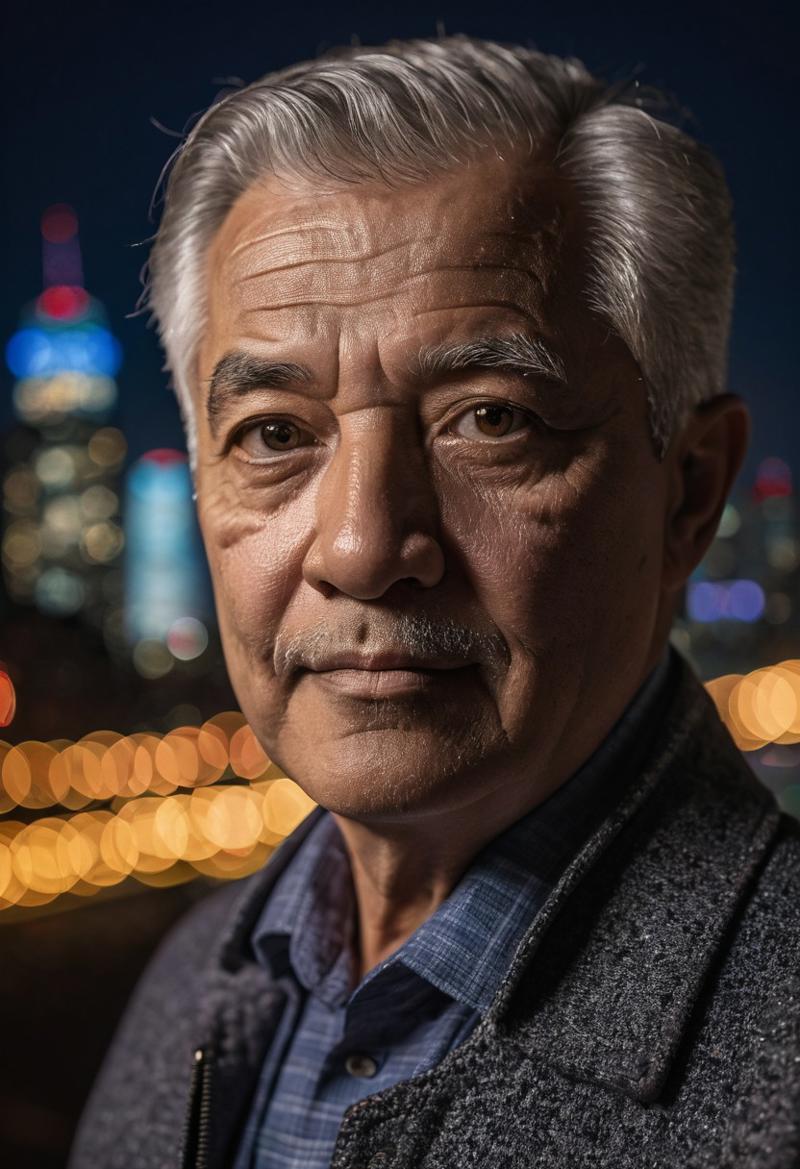
Lighting equipment
While shooting in studio, we have different lightformers, that can also be used within a prompt.
[LIGHTING EQUIPMENT] Main prompt, other parts of the prompt Beauty ring/ Ring flash
A beauty ring, also known as a ring light or ring flash, is a circular-shaped lighting device used in photography to achieve even and flattering illumination, particularly in portrait and beauty shots. The ring light is positioned around the camera lens, creating a symmetrical, shadow-free lighting effect. Its circular design produces a distinct catchlight in the subject's eyes, giving a unique and captivating look. Beauty rings are valued for their ability to reduce harsh shadows and provide a soft, diffused light, enhancing skin tones and minimizing imperfections. Popular in beauty and fashion photography, the beauty ring is a versatile tool for achieving a flattering and glamorous aesthetic.
(Beauty ring:1.3) photo of a 65yo man, short grey hair, background is studio, highly detailed, Fujifilm XT-4
Flash photography
Flash photography involves the use of artificial light sources, such as electronic flash units or speedlights, to illuminate a scene or subject during photography. Flash is employed to provide additional light in situations with insufficient natural light, correct exposure, freeze motion, and reduce shadows. It can be used both on-camera and off-camera, offering versatility in controlling the direction, intensity, and quality of light. Flash photography is widely used in various genres, including portrait, event, and studio photography, as it allows photographers to overcome lighting challenges and creatively shape the illumination of their subjects. Techniques such as bounce flash, diffusers, and gels are commonly used to modify and enhance the effects of flash in different scenarios.
(flash photography:1.4) of a 65yo man, short grey hair, background is studio, highly detailed, Fujifilm XT-4
Softbox
A softbox is a versatile lighting accessory in photography, consisting of a fabric box encasing a light source, often a strobe or continuous light. The interior is lined with reflective material to ensure even light distribution, and the front is covered with a diffusion material, softening the light and reducing harsh shadows. Popular in portrait, fashion, and product photography, softboxes create a flattering and natural illumination by minimizing glare and controlling contrast. Available in various shapes and sizes, they offer photographers flexibility in tailoring the quality and direction of light to suit different subjects and scenes.
Softbox photo of a 65yo man, short grey hair, background is studio, highly detailed, Fujifilm XT-4
Speed light
A speedlight is a compact and portable electronic flash unit used in photography to provide additional light in various shooting conditions. Mounted on the camera's hot shoe or used off-camera, speedlights offer versatility and convenience. These small and powerful flashes are popular for events, portraits, and outdoor photography, providing fill light or acting as the main light source when natural light is insufficient. Speedlights are prized for their portability, quick recycling times, and the ability to modify the quality of light with diffusers and bounce techniques, making them an essential tool for photographers seeking flexible and efficient lighting solutions.
(Speed light:1.4) photo of a 65yo man, short grey hair, background is studio, highly detailed, Fujifilm XT-4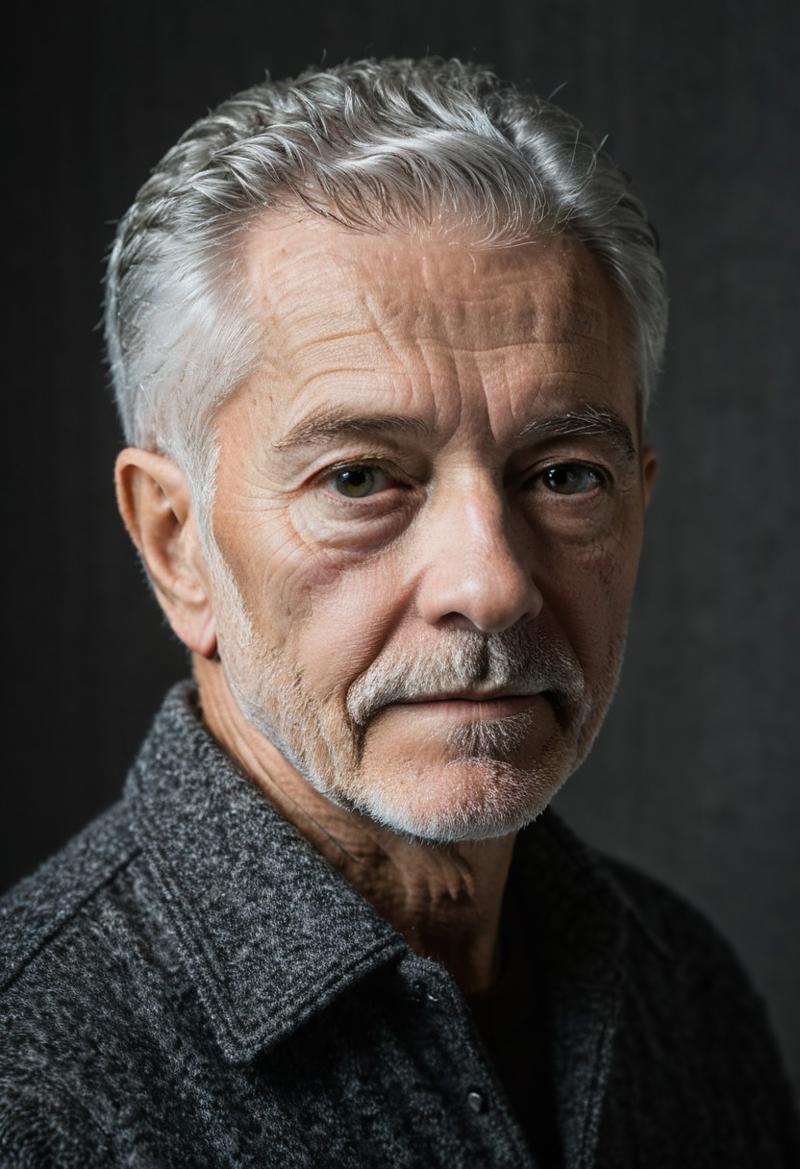
Strip light
A strip light is a specialized lighting modifier in photography, featuring a long and narrow design that produces a unique, elongated light source. Typically used in portrait and product photography, the strip light creates soft and directional illumination with minimal shadows. Its elongated shape allows for precise control over the spread of light, making it well-suited for accentuating specific features or creating highlights. The strip light is particularly effective in achieving a sleek and dramatic look, making it a popular choice for adding dimension and depth to images, especially when photographing subjects with defined contours or in tight spaces.
(Strip light:1.4) photo of a 65yo man, short grey hair, background is studio, highly detailed, Fujifilm XT-4
Lighting Keywords
It is also possible to define specific keywords, which control the lighting of an image.
Main prompt, [LIGHTING KEYWORDS], other parts of the prompt Backlight
Backlight in photography refers to a lighting setup where the primary source of light is positioned behind the subject, illuminating it from the rear. This creates a distinctive effect, with the subject appearing between the camera and the light source.
Portrait of a 65yo man, short grey hair, background is a city scene, backlight, bokeh, highly detailed, Fujifilm XT-4
Broad Lighting
Broad lighting is a photography lighting technique where the primary light source illuminates the side of the subject facing the camera. In this setup, the side of the face or the main subject that is turned towards the camera receives the majority of the light. This results in a broader, well-lit area on the side facing the camera, creating a more open and illuminated look.
Portrait of a 65yo man, short grey hair, (Broad Lighting), background is studio, highly detailed, Fujifilm XT-4
Caustics
Caustics in photography refer to the intricate patterns of light and shadow created by the refraction or reflection of light through or off a curved or uneven surface. This phenomenon often results in visually interesting and complex designs, seen commonly in images of rippling water, glass objects, or other transparent materials. Caustics are particularly captivating in their ability to cast intricate and dynamic patterns of light and shadow on surrounding surfaces. Photographers may focus on capturing caustics to emphasize the interplay of light, adding an element of visual interest and complexity to their images.
Chiaroscuro Lighting
Chiaroscuro lighting is a technique characterized by strong contrasts between light and dark areas in a photograph. Originating from Renaissance art, this method creates a dramatic interplay of light and shadow. The intentional use of pronounced shadows and bold highlights adds depth, dimension, and a sense of mood to the image. Chiaroscuro lighting is often employed in portraiture and atmospheric scenes, contributing to a timeless and visually impactful aesthetic. This style plays with the distribution of light to create a dynamic composition, enhancing the overall storytelling and emotional resonance of the photograph.
Portrait of a 65yo man, short grey hair, (Chiaroscuro Lighting:1.5), background is studio, highly detailed, Fujifilm XT-4
Cinematic lighting
Cinematic lighting in photography is a technique that emulates the lighting styles used in movies. It often involves careful control of light and shadows to create a specific mood or atmosphere, enhancing the visual storytelling of an image. Cinematic lighting techniques can include the use of soft, diffused light for a classic and flattering look or the intentional use of hard light to create dramatic effects and enhance textures. Cinematic lighting is characterized by its ability to convey emotion, add depth to the narrative, and create a visually compelling and immersive experience, reminiscent of the lighting seen in films. It often requires thoughtful placement of light sources, strategic use of shadows, and attention to the overall composition to achieve a cinematic and storytelling effect in a still image.
Portrait of a 65yo man, short grey hair, (Cinematic lighting), background is a city scene, highly detailed, Fujifilm XT-4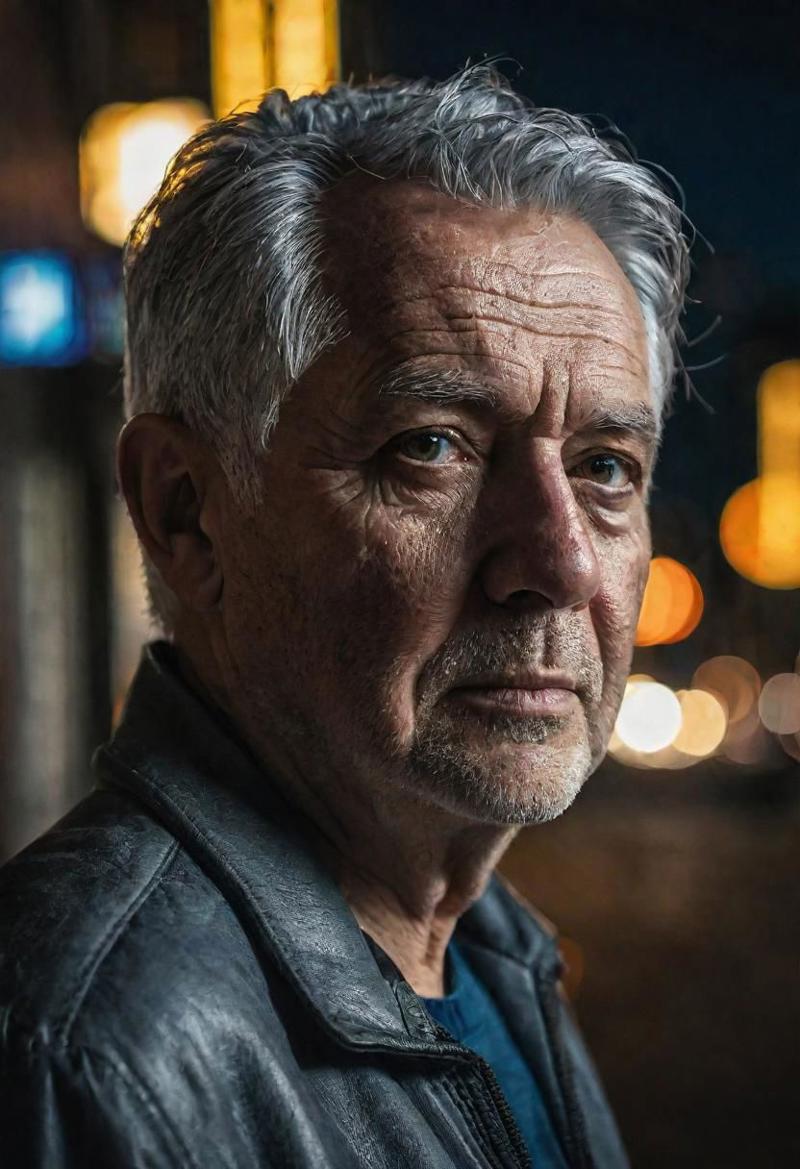
Crepuscular rays
Crepuscular rays, also known as "god rays," are a visual phenomenon observed in photography and nature. These rays of sunlight appear to radiate from the point in the sky where the sun is located and stream through gaps in clouds or other obstructions. The effect is particularly noticeable during sunrise or sunset when the sun is near the horizon.
Portrait of a 65yo man, short grey hair, (Crepuscular rays:1.5), foggy morning, background is a city scene, highly detailed, Fujifilm XT-4
Diffused lighting
Diffused lighting in photography involves using a light source that has been softened or scattered to create a gentle and even illumination, minimizing harsh shadows and reducing contrasts. This technique is achieved by passing light through a diffusing material or bouncing it off a surface to create a more uniform and flattering look. Diffused lighting is commonly used in portrait photography to achieve a soft and natural appearance, highlighting details without overly emphasizing shadows. It is also popular in product photography to create smooth highlights and even tones. The result is a pleasing, evenly lit scene that minimizes harsh highlights and shadows, producing a subtle and appealing aesthetic.
Portrait of a 65yo man, short grey hair, (Diffused lighting), background is a city scene, highly detailed, Fujifilm XT-4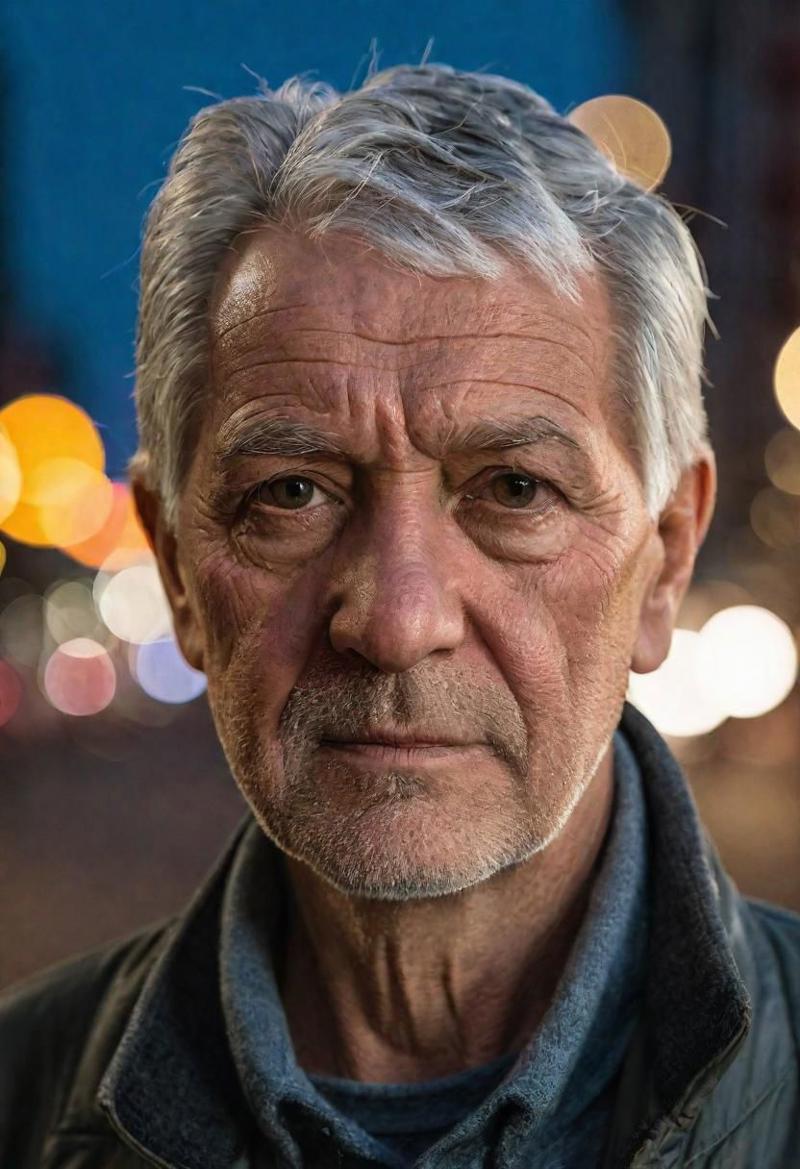
Dimly lit
Dimly lit refers to an environment or scene with low levels of illumination, creating subdued or minimal lighting conditions. In a photographic context, capturing images in dimly lit settings poses challenges as the reduced light can affect exposure, color accuracy, and detail visibility.
Dimly lit scenarios often evoke specific moods, lending a sense of intimacy, mystery, or drama to photographs. Photographers may intentionally seek or creatively utilize dim lighting to achieve certain visual effects, making it an essential aspect of photographic storytelling.
(Dimly lit:1.8) photo of a 65yo man, short grey hair, background is a city scene, highly detailed, Fujifilm XT-4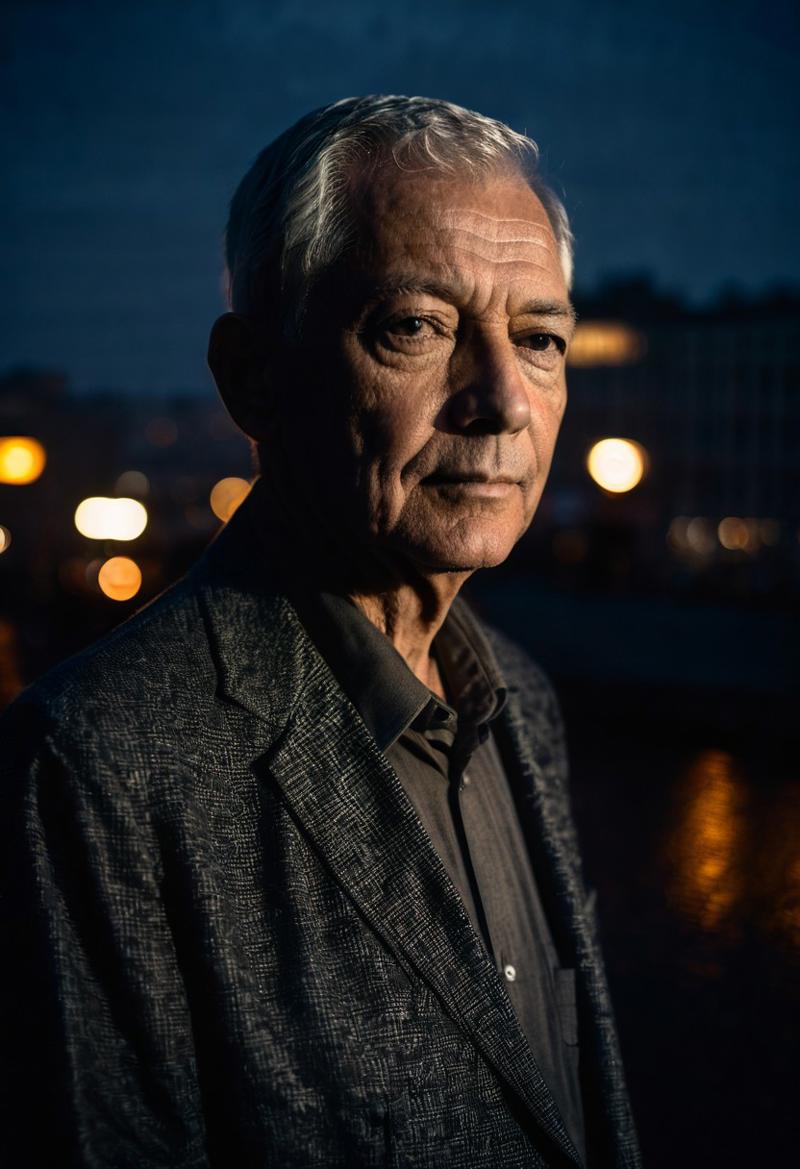
Dynamic lighting
Dynamic lighting in photography refers to the use of changing or varied lighting conditions to create visually interesting and compelling images. This technique involves capturing moments when light sources are in flux, such as during sunrise or sunset, or when artificial lights are in motion. Dynamic lighting adds a sense of drama, depth, and mood to photographs, enhancing the overall visual impact. Photographers often leverage dynamic lighting to create captivating compositions, emphasizing contrasts, shadows, and highlights. This approach allows for the exploration of different atmospheres and storytelling possibilities, making the images more engaging and dynamic.
Portrait of a 65yo man, short grey hair, (dynamic lighting), background is a city scene, highly detailed, Fujifilm XT-4
Halo lighting
Halo lighting in photography refers to a technique where a soft and diffused light source encircles the subject, creating a subtle glow or halo effect around the edges. This lighting style adds a touch of ethereal and enchanting ambiance to the image. Photographers achieve halo lighting by using backlights, rim lights, or strategically placed diffused lights to create a gentle illumination around the subject. This technique is often employed in portraits or to highlight specific elements in a composition, enhancing the overall visual appeal and creating a sense of separation between the subject and the background.
Hard Light
Hard light in photography refers to illumination that produces well-defined and sharp-edged shadows with a distinct transition between light and dark areas. This type of lighting creates strong contrasts and emphasizes textures and details. Hard light is often achieved using a small and intense light source, such as direct sunlight on a clear day or a focused spotlight. While hard light can create a dramatic and impactful look, it may also accentuate imperfections and create harsh shadows, which may not be desirable in certain situations. Photographers may use diffusers, reflectors, or modify the light source to soften the effects of hard light and achieve a more balanced and controlled result.
Portrait of a 65yo man, short grey hair, (hard light:1.4) background is studio, highly detailed, Fujifilm XT-4 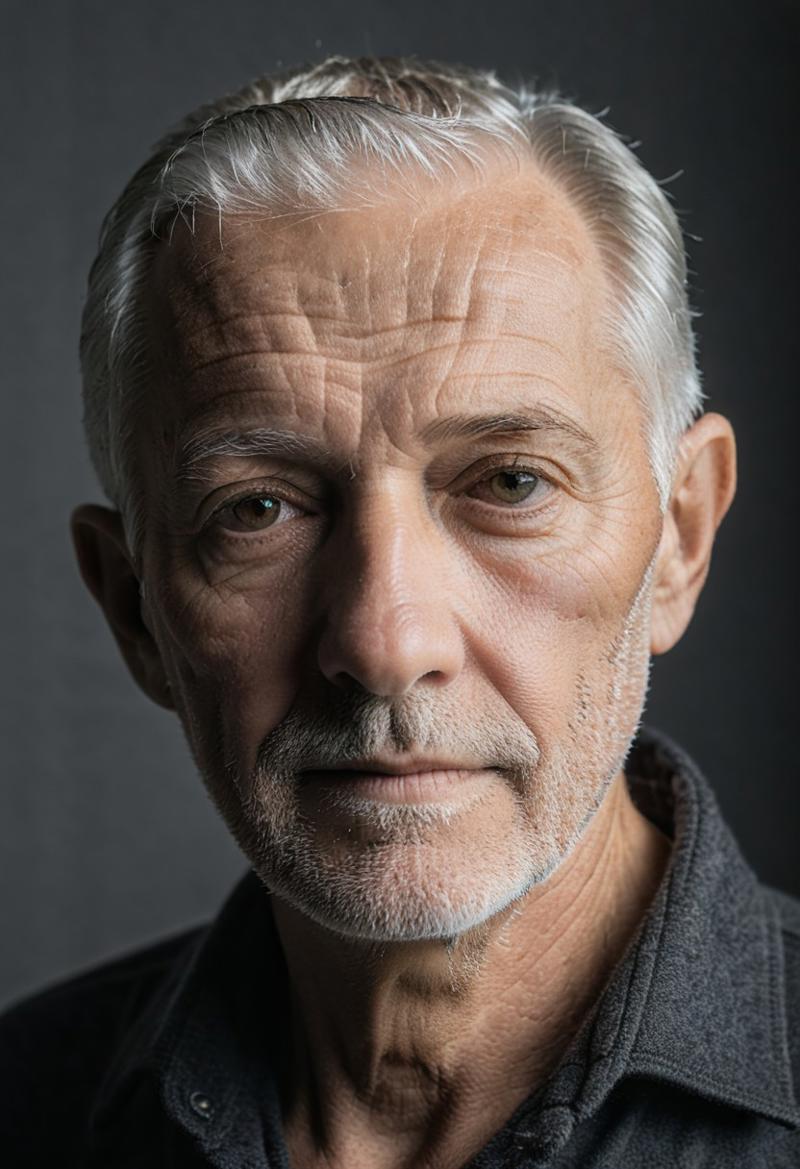
Harsh shadows
Harsh shadows in photography occur when the light source is direct, intense, and comes from a single direction, resulting in distinct, well-defined shadows with sharp edges. This type of lighting can create a dramatic and high-contrast effect, but it may also lead to undesirable shadows that distract from the overall image. Harsh shadows are often mitigated by modifying the light source, such as diffusing it with a softbox or using reflectors to bounce light onto shadowed areas. Adjusting the angle and distance of the light source can also help soften shadows, producing a more flattering and even illumination on the subject.
Portrait of a 65yo man, short grey hair, (harsh shadows) background is studio, highly detailed, Fujifilm XT-4
High Key Lighting
High key lighting is a photography lighting style characterized by bright, even illumination that minimizes shadows and creates a light and airy atmosphere. This technique often involves overexposing the scene, resulting in a predominantly bright and well-lit image. High key lighting is commonly used in genres such as fashion, beauty, and portrait photography, where the goal is to produce a flattering and upbeat aesthetic. The absence of strong shadows contributes to a soft and smooth look, emphasizing the subject's features and conveying a sense of brightness and positivity.
Portrait of a 65yo man, short grey hair, (High Key Lighting), background is studio, highly detailed, Fujifilm XT-4
Indirect lighting
Indirect lighting in photography involves illuminating a subject or scene by bouncing light off surfaces rather than directing it straight onto the subject. This method creates a soft and diffused illumination, minimizing harsh shadows and providing even lighting. Photographers achieve indirect lighting by using reflectors, diffusers, or by bouncing light off walls and ceilings. This technique is commonly used in portrait photography to achieve a flattering and natural look, as well as in interior and product photography to create a soft, ambient glow. Indirect lighting adds a gentle and pleasing quality to the photograph, offering versatility and control over the overall lighting effect.
Photo of a 65yo man standing in a dark corner, short grey hair, (Indirect lighting), background is a city scene, highly detailed, Fujifilm XT-4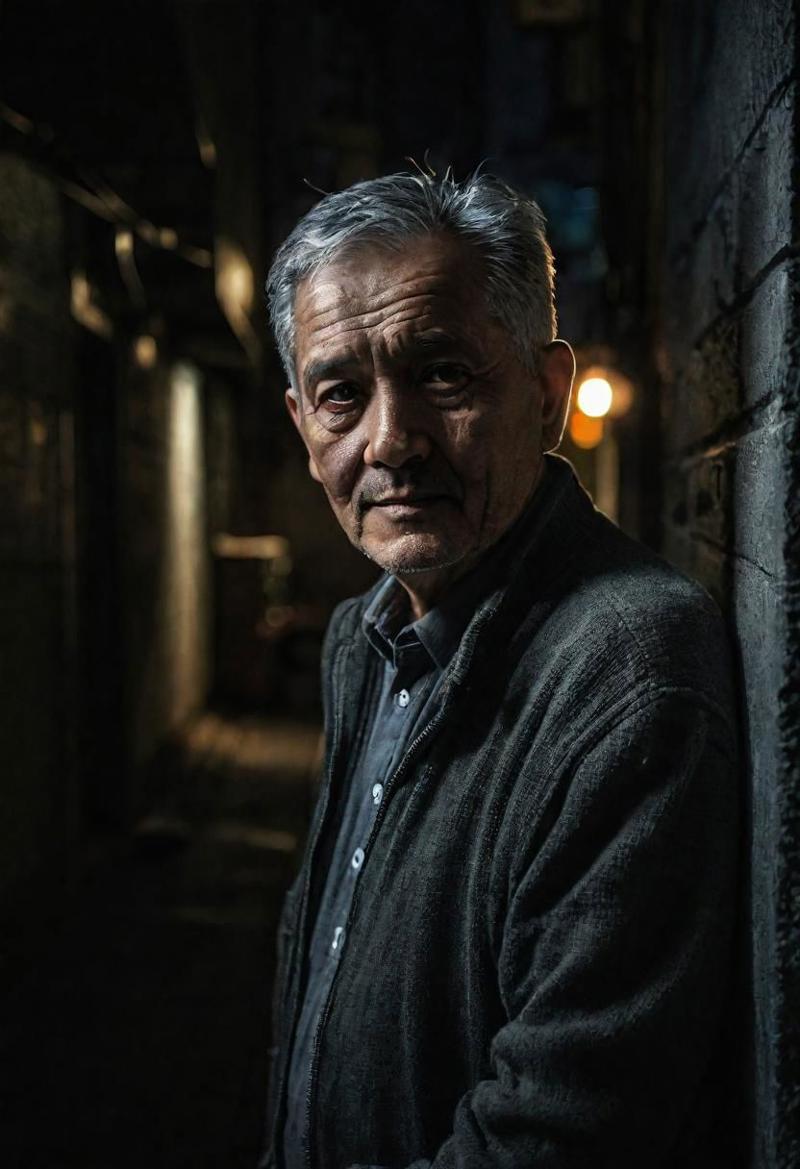
Iridescent Lighting
Iridescent in photography refers to a phenomenon where surfaces exhibit changing, shimmering colors that shift depending on the angle of view or the angle of illumination. This captivating effect is often caused by the interference, diffraction, or scattering of light waves. Examples of iridescence can be found in various subjects, such as soap bubbles, certain minerals, butterfly wings, and oil slicks on water. Photographers may capture iridescence by carefully controlling lighting conditions or by highlighting the specific materials that exhibit this colorful and dynamic quality. The result is visually stunning images that showcase the play of iridescent colors across the photographed subject.
Portrait of a 65yo man, short grey hair, (Iridescent lighting), background is a city scene, highly detailed, Fujifilm XT-4
Loop Lighting
Loop lighting is a popular and flattering photography lighting technique commonly used in portrait photography. It involves placing the key light source at approximately a 45-degree angle to the subject and slightly above eye level. The result is a distinctive loop-shaped shadow that forms on the opposite side of the nose, creating a subtle and pleasing lighting pattern.
Portrait of a 65yo man, short grey hair, (Loop Lighting:1.3), background is studio, highly detailed, Fujifilm XT-4
Low Key Lighting
Low key lighting is a photography lighting style distinguished by the predominant use of shadows and contrast to create a moody and dramatic atmosphere. In low key lighting, the scene is intentionally underexposed, emphasizing darker tones and creating a play between light and shadow. This style is often employed in genres such as film noir, portraits, and dramatic storytelling, where the goal is to evoke a sense of mystery, intensity, or emotion. Low key lighting adds depth and visual interest by selectively illuminating specific areas, leaving other parts of the composition in shadow, resulting in a powerful and impactful visual effect.
Portrait of a 65yo man, short grey hair, (Low Key Lighting), background is studio, highly detailed, Fujifilm XT-4
Luminescent lighting
Also called Luminescence. Luminescence in photography refers to the emission of light by a substance that is not primarily caused by heat. It is a form of self-generated or induced light, often associated with materials that have the ability to emit light after exposure to external stimuli like radiation or an electric field. In some photographic contexts, the term may be used to describe the quality or intensity of light in an image. Luminescent materials, such as certain pigments or coatings, can be strategically used in photography to create unique visual effects or enhance specific elements in a composition. Understanding and harnessing luminescence adds a creative dimension to photographic work, allowing photographers to experiment with different light sources and materials for artistic expression.
Portrait of a 65yo man, short grey hair, (luminescent lighting), background is a city scene, highly detailed, Fujifilm XT-4For our simple prompt, this does not have that much effect.
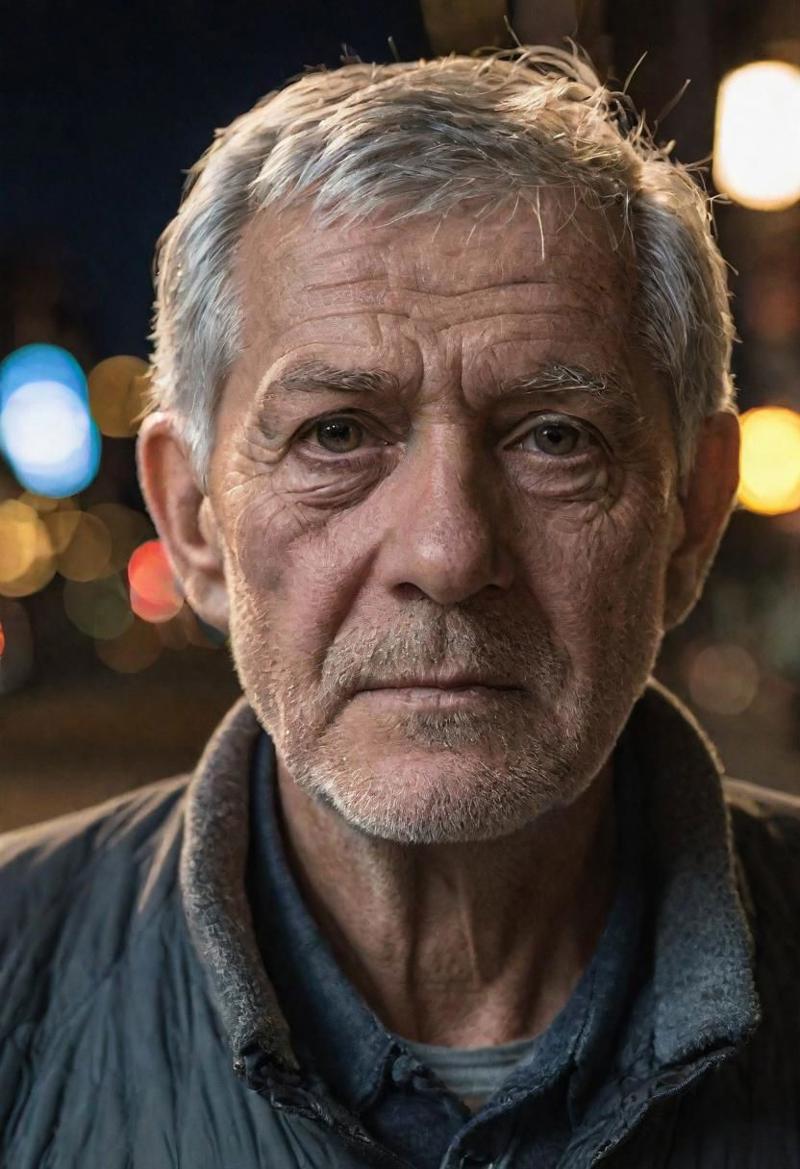
Noir Lighting
Noir lighting, inspired by the film noir genre, is characterized by low key lighting, dramatic shadows, and high contrast. This style creates a mysterious and moody atmosphere, often associated with crime or detective narratives. Noir lighting emphasizes the interplay of light and shadow, casting dark and intriguing scenes that contribute to a sense of suspense and intrigue. It typically involves the use of harsh and directional lighting to enhance the contrast between light and dark areas, creating a visually striking and cinematic effect. Noir lighting is widely used in photography, especially for storytelling or capturing the evocative essence of classic film noir aesthetics.
Portrait of a 65yo man, short grey hair, (Noir Lighting:1.5), background is studio, highly detailed, Fujifilm XT-4
Radiant light rays
Radiant light rays refer to beams of light that extend outward from a central source, creating a visually striking and dynamic effect. In photography, this phenomenon is often captured when sunlight or artificial light interacts with particles or atmospheric elements, leading to the visible projection of rays. Radiant light rays can add a sense of drama, depth, and atmosphere to an image, particularly during sunrise or sunset when the sun is near the horizon. Photographers may emphasize or enhance these rays through composition, exposure, or post-processing techniques to create captivating visuals that draw attention to the play of light in the scene.
Portrait of a 65yo man, short grey hair, (Radiant light rays), background is a city scene, highly detailed, Fujifilm XT-4
Rembrandt Lighting
Rembrandt lighting is a classic and widely used portrait lighting technique named after the famous Dutch painter Rembrandt Harmenszoon van Rijn, who often used this type of lighting in his paintings. This technique creates a distinctive triangular highlight on one side of the subject's face, formed by a small, angled light source. The rest of the face is usually in shadow, resulting in a dramatic and visually striking effect.
Portrait of a 65yo man, short grey hair, (Rembrandt Lighting:1.3), background is studio, highly detailed, Fujifilm XT-4
Rim lighting
Rim lighting is a photography and cinematography technique where a strong light source is placed behind the subject, creating a bright outline or "rim" of light along the edges of the subject. This effect helps separate the subject from the background, adding depth and emphasizing its contours. Rim lighting is commonly used to create a visually striking and three-dimensional look, particularly in portraits or when highlighting specific details in a scene. The technique contributes to a sense of drama and can be achieved using natural light, artificial lights, or a combination of both, depending on the desired effect.
Portrait of a 65yo man, short grey hair, (Rim lighting), background is a city scene, highly detailed, Fujifilm XT-4
Shimmering light
Shimmering light in photography refers to the dynamic and sparkling effect produced when light reflects off or interacts with surfaces, creating a visually captivating play of highlights and reflections. This phenomenon is often seen in scenes involving water, glass, or other reflective materials. Photographers may capture shimmering light by adjusting their composition to emphasize the reflections, using the right angles to enhance the effect. This technique adds a sense of movement and vibrancy to the image, creating an enchanting and lively visual experience. Shimmering light is particularly effective during sunrise or sunset, when the low-angle sunlight interacts with the environment, intensifying the sparkling effect.
Photo of a 65yo man leaning against a glass surface, short grey hair, (Shimmering light), background is a city scene, highly detailed, Fujifilm XT-4
Soft Light
Soft light in photography refers to illumination that produces gentle and diffused shadows, creating smooth transitions between light and shadowed areas. This type of lighting minimizes harsh contrasts and highlights, resulting in a flattering and natural-looking appearance, particularly in portrait photography. Soft light is often achieved using light modifiers such as softboxes, umbrellas, or by utilizing natural light through overcast skies. These modifiers scatter and diffuse the light source, creating a larger and more even illumination that bathes the subject in a soft and pleasing glow. Soft light is valued for its ability to enhance textures, reduce imperfections, and create a visually appealing, gentle atmosphere in photographs.
Portrait of a 65yo man, short grey hair, (soft light:1.4) background is studio, highly detailed, Fujifilm XT-4
Soft shadows
Soft shadows in photography occur when the light source is diffused or scattered, creating gentle, gradual transitions between illuminated and shadowed areas. This type of lighting results in shadows with softer edges, minimizing the contrast between light and dark. Soft shadows are often associated with flattering and natural-looking illumination, particularly in portrait and product photography. Achieving soft shadows can be done using modifiers like softboxes, umbrellas, or by utilizing natural light through overcast skies. The diffusion of light helps distribute it evenly, reducing harsh contrasts and creating a smoother, more pleasing aesthetic in the photograph.
Portrait of a 65yo man, short grey hair, (soft shadows:1.4) background is studio, highly detailed, Fujifilm XT-4
Subsurface scattering
Subsurface scattering is a lighting phenomenon in photography and computer graphics that simulates the way light interacts with translucent materials, such as skin, wax, or marble. In subsurface scattering, light penetrates the surface of a material, scatters within it, and then exits at a different point. This effect contributes to the realistic rendering of materials, especially in situations where light penetrates and diffuses through surfaces, creating a soft and natural appearance. In photography, this phenomenon is often replicated using specialized lighting setups or post-processing techniques to accurately capture the nuanced interaction between light and materials, particularly in portraiture where lifelike skin tones are crucial.
Portrait of a 65yo man, short grey hair, (Subsurface scattering), background is a city scene, highly detailed, Fujifilm XT-4For our simple prompt, this does not have that much effect.

Sunlight
In a photographic context, sunlight refers to the natural illumination provided by the sun. It plays a central role in shaping the visual characteristics of a photograph, influencing factors such as the direction, color temperature, and quality of light. Photographers often consider the position of the sun in the sky to optimize the composition, manage shadows, and harness the creative possibilities offered by different times of the day. The interaction between sunlight and the environment contributes significantly to the mood, atmosphere, and overall aesthetics of a photograph, making it a crucial element in photographic storytelling and visual expression.
Portrait of a 65yo man, short grey hair, (Sunlight), background is a city scene, highly detailed, Fujifilm XT-4
Translucencent lighting
Translucent lighting in photography involves illuminating a subject through a semi-transparent or diffusing material, allowing light to pass through and create a soft, even glow. This technique is often used to reduce harsh shadows and highlight details, producing a flattering and gentle illumination. Common examples include shooting through fabrics, diffusers, or even natural elements like fog or mist. Translucent lighting is popular in portrait and product photography for its ability to create a pleasing and ethereal atmosphere, adding a touch of delicacy to the visuals. Photographers strategically use this technique to control and manipulate the quality of light, achieving a soft and diffused look in their compositions.
Portrait of a 65yo man, short grey hair, (Translucencent lighting), background is a city scene, highly detailed, Fujifilm XT-4
Volumetric lighting
Volumetric lighting is a cinematic and photographic effect where light interacts with particles or atmospheric conditions, creating visible rays or beams. This directional and atmospheric enhancement adds drama, depth, and an ethereal quality to images, especially when light passes through mediums like air or mist. Photographers and filmmakers often capture this effect in natural conditions, such as foggy environments, or intentionally create it using artificial lighting sources for a visually captivating impact.
Portrait of a 65yo man, short grey hair, background is a city scene, misty morning, (volumetric lighting), highly detailed, Fujifilm XT-4
Time of the day
The time of day significantly impacts photographic lighting. During the golden hour at sunrise and sunset, the sun casts a warm and soft light, creating a magical atmosphere with enhanced colors and gentle shadows. Midday brings more direct and intense lighting, producing bright and contrasty conditions, suitable for a crisp aesthetic. As the day progresses into the afternoon and evening, lighting softens, and warm tones return, leading to the blue hour, a captivating period for cityscapes and landscapes. Understanding these variations allows photographers to manipulate mood, highlight textures, and craft visually compelling images.
Main prompt, [TIME OF DAY], other parts of the prompt Dawn
Dawn is the early period of the day, occurring just before sunrise when the sky transitions from darkness to light. It is marked by the soft glow of the approaching sun on the horizon. Dawn provides a serene and tranquil atmosphere, with a palette of warm colors during the golden hour. Photographers often cherish this time for its magical and ethereal qualities, capturing landscapes, cityscapes, and portraits with a gentle and flattering light. Dawn is a moment of quiet beauty, offering unique opportunities for creating visually captivating images as the world awakens to the new day.
Photo of a 65yo man, short grey hair, (dawn:1.5) , background is a city scene, highly detailed, Fujifilm XT-4
Dusk
Dusk is the transitional period between sunset and darkness, characterized by diminishing natural light. During this time, the sky displays a range of colors, including warm tones during the golden hour and cooler hues during the blue hour. Dusk creates a serene and atmospheric environment, offering unique opportunities for capturing cityscapes, landscapes, and portraits with a blend of natural and artificial lighting. Photographers often leverage the changing light conditions during dusk to create visually compelling and moody compositions, taking advantage of the soft, diffused illumination that defines this magical time of day.
Portrait of a 65yo man, short grey hair, (dusk:1.5) , background is a city scene, highly detailed, Fujifilm XT-4
Evening light
Evening light, particularly during the golden hour around sunset, is characterized by a soft and warm glow. As the sun descends, its rays pass through a thicker atmosphere, creating a rich, golden illumination with long shadows. This magical lighting enhances colors, textures, and depth, offering a serene and enchanting atmosphere similar to morning light. Photographers often favor evening light for its flattering and soft look, making it ideal for various scenes, from landscapes to portraits. The lower angle of the sun minimizes harsh shadows, creating a gentle and appealing aesthetic as the day transitions into night.
Portrait of a 65yo man, short grey hair, (evening light:1.5) , background is a city scene, highly detailed, Fujifilm XT-4
Noon light
Noon light, occurring when the sun is at its zenith, creates a more direct and intense illumination. The higher angle of the sun generates shorter shadows and a brighter, contrasty look. While midday lighting is less diffuse than morning or evening light, it is suitable for achieving a crisp and vibrant aesthetic. However, photographers need to manage potential challenges, such as harsh shadows and highlights. Noon light is often used when a bold and dynamic visual impact is desired, particularly in outdoor settings with ample sunlight.
Portrait of a 65yo man, short grey hair, (noon light:1.2) , background is a city scene, highly detailed, Fujifilm XT-4
Moon light
Moonlight is the soft illumination provided by the moon during nighttime. Its gentle, diffused nature creates a tranquil atmosphere with a cool, bluish hue. Ideal for night photography, moonlight allows for capturing subtle details and shadows, imparting a serene and mysterious mood to the scenes. Photographers often use longer exposures to convey the ethereal beauty of moonlit landscapes, creating unique and evocative compositions.
Portrait of a 65yo man, short grey hair, (Moonlight:1.5) , background is a city scene, highly detailed, Fujifilm XT-4
Morning light
Morning light, especially during the golden hour around sunrise, is known for its soft, warm, and directional quality. This beautiful illumination, characterized by a golden hue and long shadows, enhances colors and textures while creating a magical atmosphere. Photographers appreciate morning light for its flattering and gentle look, making it ideal for capturing a variety of scenes from landscapes to portraits.
Portrait of a 65yo man, short grey hair, (morning light), background is a city scene, highly detailed, Fujifilm XT-4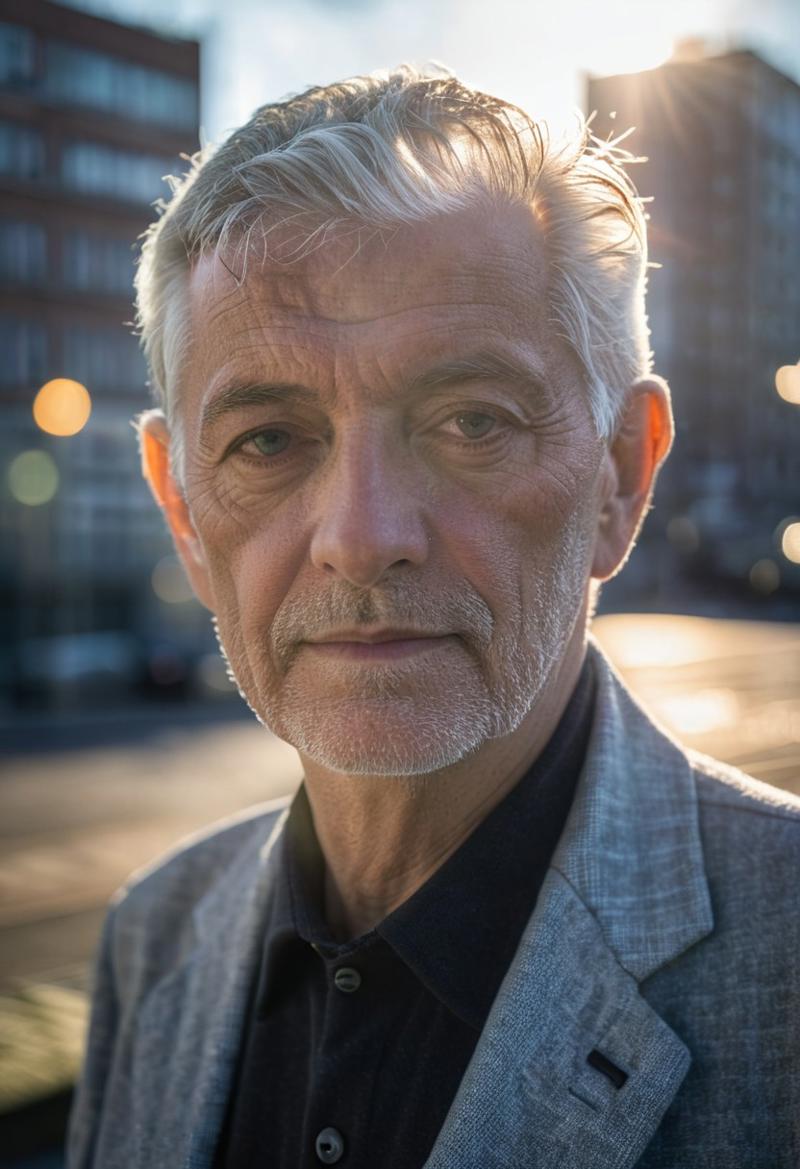
Star light
Starlight is the faint illumination produced by stars in the night sky. This low-intensity light creates a dark and celestial atmosphere, providing a unique backdrop for astrophotography. Capturing the brilliance of stars often involves long exposure times to reveal their intricate patterns and to bring out the details in the night sky. Starlight photography offers a glimpse into the vastness of the universe, allowing photographers to create captivating and awe-inspiring images of the night celestial panorama.
In combination with portraits or photos of persons, the person will still get "light" and only the background is affected.
Dimly lit Photo of a 65yo man, short grey hair, (Starlight:1.5) 